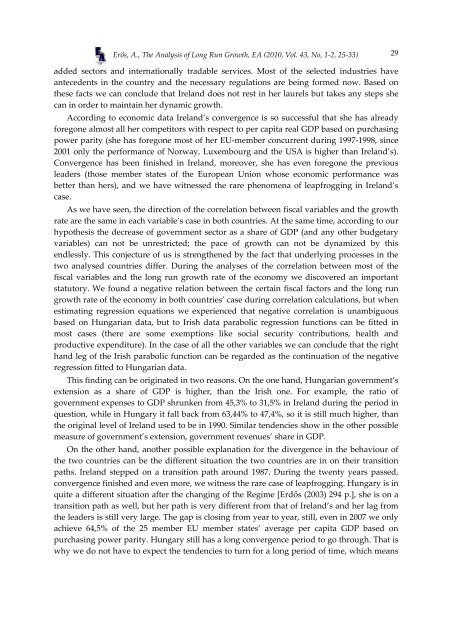Twice a Year Scientific Journal
Twice a Year Scientific Journal
Twice a Year Scientific Journal
Create successful ePaper yourself
Turn your PDF publications into a flip-book with our unique Google optimized e-Paper software.
Erös, A., The Analysis of Long Run Growth, EA (2010, Vol. 43, No, 1-2, 25-33) 29<br />
added sectors and internationally tradable services. Most of the selected industries have<br />
antecedents in the country and the necessary regulations are being formed now. Based on<br />
these facts we can conclude that Ireland does not rest in her laurels but takes any steps she<br />
can in order to maintain her dynamic growth.<br />
According to economic data Ireland’s convergence is so successful that she has already<br />
foregone almost all her competitors with respect to per capita real GDP based on purchasing<br />
power parity (she has foregone most of her EU-member concurrent during 1997-1998, since<br />
2001 only the performance of Norway, Luxembourg and the USA is higher than Ireland’s).<br />
Convergence has been finished in Ireland, moreover, she has even foregone the previous<br />
leaders (those member states of the European Union whose economic performance was<br />
better than hers), and we have witnessed the rare phenomena of leapfrogging in Ireland’s<br />
case.<br />
As we have seen, the direction of the correlation between fiscal variables and the growth<br />
rate are the same in each variable’s case in both countries. At the same time, according to our<br />
hypothesis the decrease of government sector as a share of GDP (and any other budgetary<br />
variables) can not be unrestricted; the pace of growth can not be dynamized by this<br />
endlessly. This conjecture of us is strengthened by the fact that underlying processes in the<br />
two analysed countries differ. During the analyses of the correlation between most of the<br />
fiscal variables and the long run growth rate of the economy we discovered an important<br />
statutory. We found a negative relation between the certain fiscal factors and the long run<br />
growth rate of the economy in both countries’ case during correlation calculations, but when<br />
estimating regression equations we experienced that negative correlation is unambiguous<br />
based on Hungarian data, but to Irish data parabolic regression functions can be fitted in<br />
most cases (there are some exemptions like social security contributions, health and<br />
productive expenditure). In the case of all the other variables we can conclude that the right<br />
hand leg of the Irish parabolic function can be regarded as the continuation of the negative<br />
regression fitted to Hungarian data.<br />
This finding can be originated in two reasons. On the one hand, Hungarian government’s<br />
extension as a share of GDP is higher, than the Irish one. For example, the ratio of<br />
government expenses to GDP shrunken from 45,3% to 31,5% in Ireland during the period in<br />
question, while in Hungary it fall back from 63,44% to 47,4%, so it is still much higher, than<br />
the original level of Ireland used to be in 1990. Similar tendencies show in the other possible<br />
measure of government’s extension, government revenues’ share in GDP.<br />
On the other hand, another possible explanation for the divergence in the behaviour of<br />
the two countries can be the different situation the two countries are in on their transition<br />
paths. Ireland stepped on a transition path around 1987. During the twenty years passed,<br />
convergence finished and even more, we witness the rare case of leapfrogging. Hungary is in<br />
quite a different situation after the changing of the Regime [Erdős (2003) 294 p.], she is on a<br />
transition path as well, but her path is very different from that of Ireland’s and her lag from<br />
the leaders is still very large. The gap is closing from year to year, still, even in 2007 we only<br />
achieve 64,5% of the 25 member EU member states’ average per capita GDP based on<br />
purchasing power parity. Hungary still has a long convergence period to go through. That is<br />
why we do not have to expect the tendencies to turn for a long period of time, which means
















